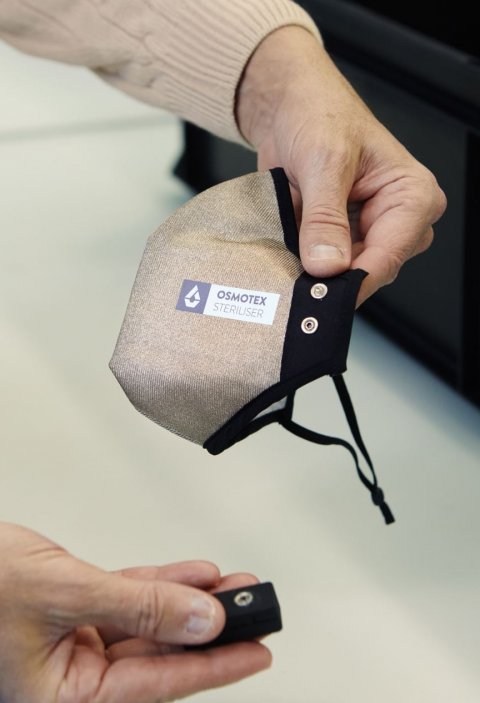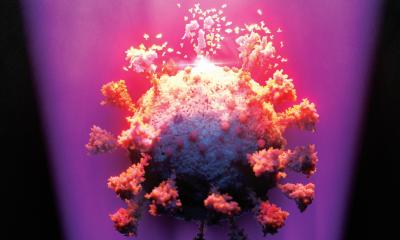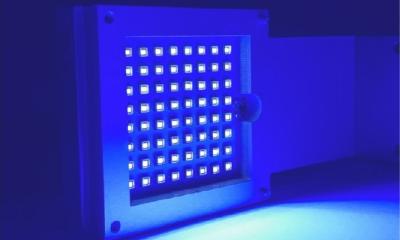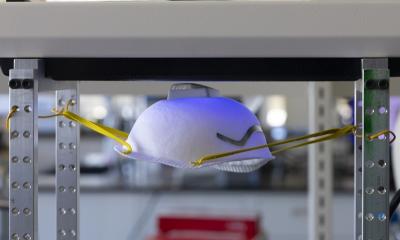Photo: ZHAW / Hannes Heinzer
News • Inactivation of Coronavirus & Co. via electrochemistry
Antiviral mask offers protection at the push of a button
Researchers at ZHAW Zurich University of Applied Sciences are working with the Swiss company Osmotex AG to develop a self-disinfecting mask that inactivates viruses at the push of a button.
The prototype of this mask made of electrochemical textiles shows an antiviral effect of over 99 percent. Further applications such as sterilizable seat covers are being examined.

Photo: ZHAW / Hannes Heinzer
Whether made of cellulose or fabric, protective masks have become an integral part of our everyday lives. In today’s models, their protective effect is based on the filtering effect of aerosols or, in addition, on the passive inactivation of viruses by means of metal-coated, charged surfaces, for example by silver cations. For the masks to provide reliable protection, they must be worn correctly and replaced or washed properly in good time. A protective mask that can be sterilized at any time at the push of a button would has decisive advantages. This is where ZHAW and the Swiss company Osmotex from Thalwil come in. With a novel electrochemical technology, viruses and other pathogens can not only be made harmless by a passive inactivation process but in addition by a fast and highly efficient active process. A prototype of this mask is currently being optimized by three research groups at the ZHAW Institute for Chemistry and Biotechnology in Wädenswil. The researchers were able to prove that the novel mask is safe and harmless to health. It should be ready for the market no later than spring 2021.
According to Osmotex’ chief technologist Trond Heldal, the results so far are promising. “Our Sterilizer Mask would be the first mask in the world that can be electrochemically sterilized – quickly and reliably. We have already patented the corresponding process,” explains Heldal. “Thanks to the ZHAW’s scientific know-how, we were able to optimize the mask and bring it to market readiness within a short time.” The project, initiated jointly by ZHAW chemist Chahan Yeretzian and Osmotex, is supported by the federal funding agency Innosuisse with over 900,000 francs and has a budget of 1.7 million francs. While Chahan Yeretzian’s team is dedicated to the safety of the mask, the team of ZHAW microbiologist Martin Sievers is responsible for the efficiency, whereas the team of ZHAW chemist Christian Adlhart is responsible for the material. “After we documented the effectiveness of the electrochemical technology in a study in summer 2020, we are now working on optimizing this technology for sterile protective masks and making it suitable for everyday use,” says Yeretzian.

Photo: ZHAW / Hannes Heinzer
The structure of the new mask consists of a multi-layer special material as well as electrodes and a voltage source. It hence resembles a sandwich: there is an insulating membrane between a layer of conductive textiles. Thanks to an integrated power source that can be recharged via a USB connection, a small electrical voltage is applied at the push of a button. This generates reactive oxygen molecules that reliably inactivate viruses and bacteria. In this way, the surface of the mask can be sterilized in a few minutes – and even while it is being worn. The voltage applied and the reactive oxygen molecules generated are minimal and harmless to humans.
Which reactive oxygen molecules are produced and how efficiently they inactivate the pathogens depends on the voltage and materials used. The ZHAW researchers are currently looking for the optimal mixture in the laboratory. “Depending on the potential and structure of the textile, we can achieve virus inactivation of over 99 percent, with far higher requirements and in a shorter time than recommended for antiviral textiles,” says ZHAW project manager Sebastian Opitz. The sterilization efficiency could therefore be specifically adapted depending on the area of application.
Electrochemical sterilization could even be an answer to the growing problem of multi-resistant hospital germs
Chahan Yeretzian
The great potential of Osmotex’s electrochemical process was shown earlier in the development of “intelligent” sports textiles that actively transport sweat to the outside. As part of the Innosuisse project, Osmotex and the ZHAW researchers want to expand this technology to other applications, such as seat covers and other textiles in public areas. The list of potential areas of application is long: hospitals, rescue teams, hotels, public transport, offices or workplaces. In this way, expensive and potentially dangerous chemical substances or UV systems could be replaced. “Electrochemical sterilization could even be an answer to the growing problem of multi-resistant hospital germs,” says Chahan Yeretzian. However, everyday applications are also conceivable. For example, a handbag could be used for simple sterilization of objects such as keys, cell phones or coins.
Source: ZHAW Zurich University of Applied Sciences
18.02.2021











